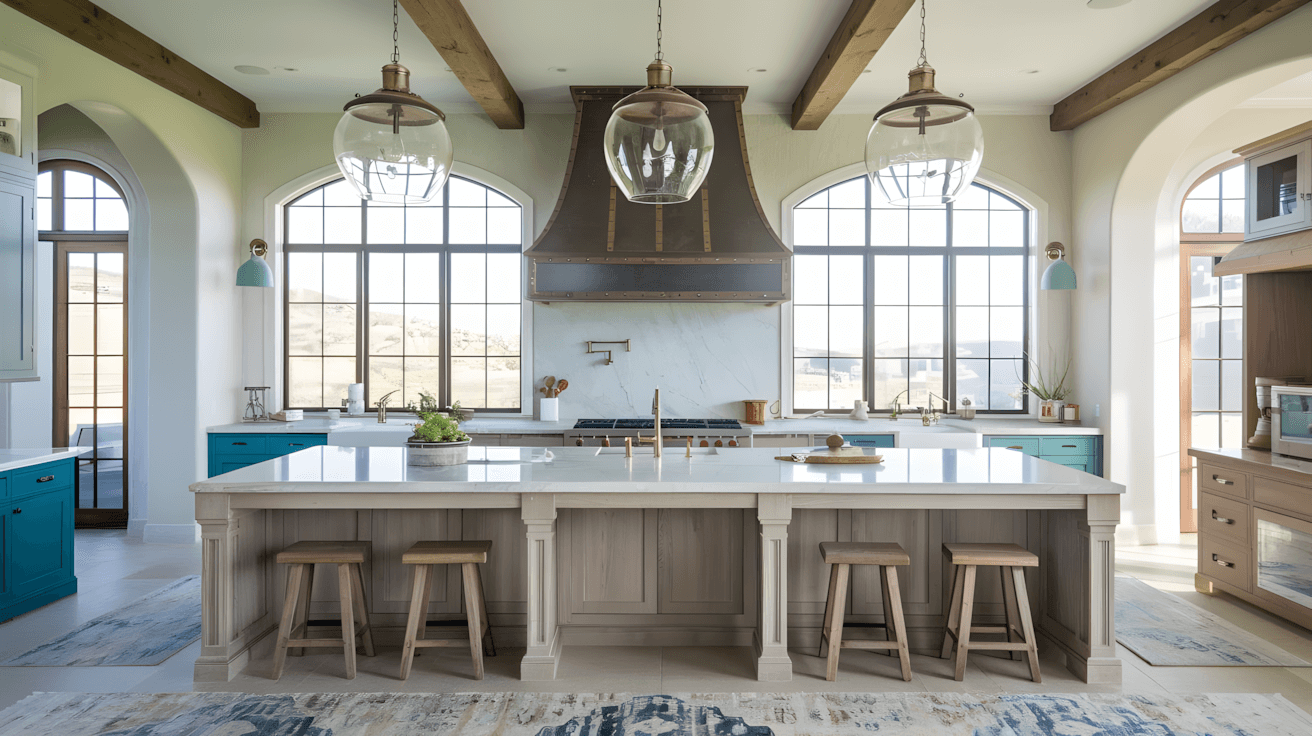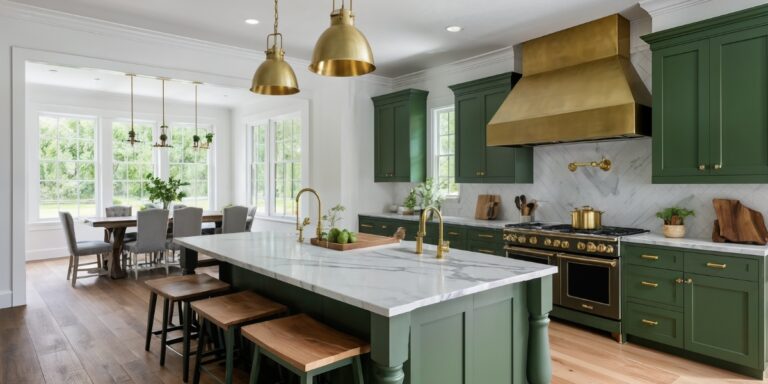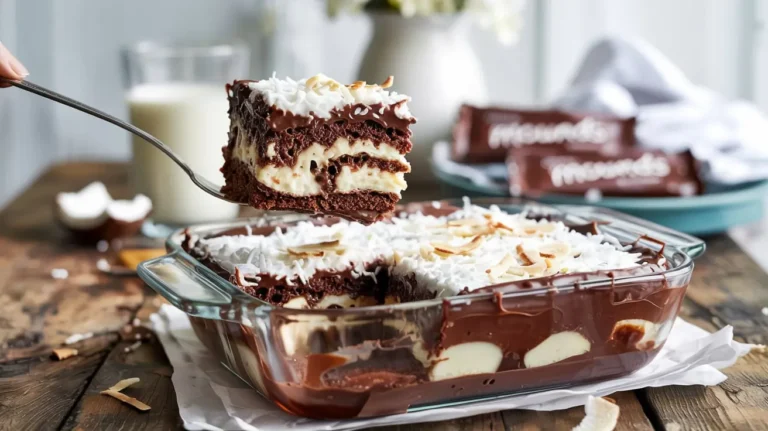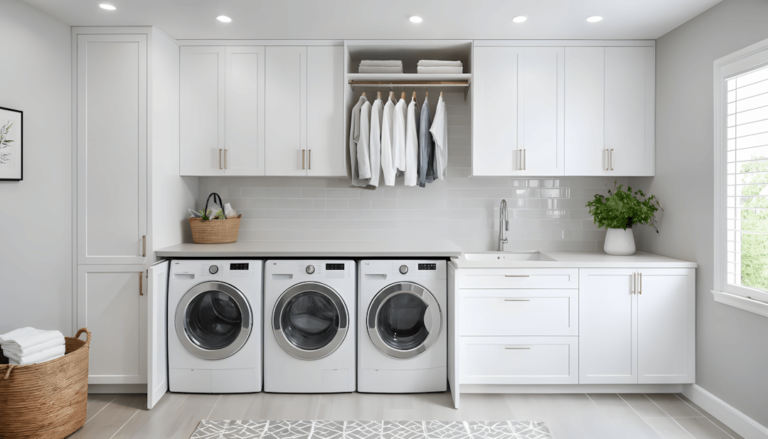After designing Spanish-style kitchens for homeowners who want to capture Mediterranean warmth without sacrificing modern functionality, I’ve discovered that creating an authentic Spanish kitchen requires understanding both the cultural cooking traditions that shaped the aesthetic and the practical demands of contemporary family life.
From my experience working with families on Spanish-inspired kitchen renovations, I’ve learned which rustic elements genuinely enhance cooking and entertaining versus which trendy features become maintenance nightmares.
These 15 kitchens represent successful projects that balance authentic Spanish character with the durability, storage, and workflow efficiency that modern families actually need.
Understanding Authentic Spanish Kitchen Design
Traditional Spanish kitchens evolved from practical necessities: cooking with limited fuel sources, preserving food in hot climates, and accommodating large family gatherings. Elements like terracotta tiles, thick walls, and central work islands served specific functions—heat resistance, thermal regulation, and efficient food preparation.
Modern Spanish kitchens succeed when they honor these functional origins while incorporating contemporary conveniences.
Rustic Modern Foundations
1. Rustic Modern Elegance Balance

This approach demonstrates how traditional Spanish elements can enhance rather than compromise modern kitchen functionality.
Key Functional Elements:
- Terracotta tile flooring for heat resistance – provides natural cooling underfoot while withstanding spills and high traffic
- White decorative range hood for ventilation efficiency – combines traditional aesthetics with modern cooking exhaust requirements
- Dark hardware on white cabinets for durability – uses materials that age gracefully while maintaining clean appearance
- Wooden ceiling beams for structural and visual warmth – adds authentic character while serving actual structural purposes
Functionality insight: Authentic Spanish materials often perform better than modern alternatives in kitchen environments—terracotta stays cooler, wood provides natural antibacterial properties, and thick walls offer superior sound dampening.
2. Statement Island with Traditional Workflow

This central island approach reflects traditional Spanish kitchen organization while accommodating modern entertaining needs.
Key Functional Elements:
- Marble countertop for pastry and bread preparation – provides naturally cool surface essential for traditional Spanish baking
- Four-stool seating for family interaction – recreates the social cooking environment central to Spanish food culture
- Ornate pendant lighting for task illumination – ensures proper lighting for detailed food preparation tasks
- Tile backsplash for easy cleaning – provides practical protection while adding authentic pattern interest
Cultural authenticity: Spanish kitchens traditionally centered around a large work surface where multiple family members could participate in food preparation—this design maintains that social cooking tradition.
3. Contemporary Rustic Fusion

This approach shows how contemporary elements can enhance traditional Spanish functionality without compromising authenticity.
Key Functional Elements:
- Dark blue island for visual grounding – provides contrast while using colors traditional in Spanish ceramics
- Open wooden shelving for display storage – allows easy access to frequently used items while showcasing beautiful cookware
- Large arched openings for cross-ventilation – facilitates air circulation essential in Mediterranean climates
- Strategic window placement for natural light – maximizes daylight for food preparation tasks
Modern integration: Contemporary storage solutions and appliances work best when they support rather than replace traditional Spanish cooking methods and social patterns.
Pattern and Material Integration
4. Bold Pattern with Practical Application

This design demonstrates how traditional Spanish patterns can serve functional purposes in modern kitchens.
Key Functional Elements:
- Geometric backsplash for visual focus – creates interest while providing practical splash protection behind cooking areas
- Wooden cabinets with quality hardware – ensures longevity while maintaining authentic material connection
- Modern hood with traditional proportions – provides necessary ventilation while respecting Spanish architectural scale
- Natural light optimization through window placement – reduces artificial lighting needs while highlighting material textures
Pattern purpose: Traditional Spanish kitchen patterns weren’t merely decorative—they often indicated functional areas, hid stains, and provided visual relief during long cooking sessions.
5. Elegant View Integration

This spacious approach shows how Spanish kitchens can maximize outdoor connections while maintaining interior functionality.
Key Functional Elements:
- Mixed cabinetry for varied storage needs – combines closed storage for everyday items with open display for special pieces
- Large arched windows for indoor-outdoor connection – maintains the Spanish tradition of integrating interior and exterior spaces
- Marble-topped island for multiple functions – serves as prep space, serving area, and informal dining location
- Quality pendant lighting for layered illumination – provides both ambient and task lighting for different activities
Spatial planning: Spanish kitchens traditionally maximized connections to outdoor spaces for climate control and herb garden access.
6. Cozy Rustic Functionality

This intimate approach demonstrates how Spanish kitchen warmth can be achieved without sacrificing modern convenience.
Key Functional Elements:
- Wooden island for warm work surface – provides naturally antibacterial cutting and prep surface
- Woven pendant lighting for authentic atmosphere – uses traditional materials while providing adequate task lighting
- Large window for natural ventilation – reduces cooking odors and heat buildup naturally
- Display storage for frequently used items – keeps essentials accessible while creating lived-in authenticity
Intimacy factor: Smaller Spanish kitchens often feel more authentic because they recreate the close-knit cooking environment of traditional homes.
Authentic Color and Texture Applications
7. Earth Tone Spanish Influence
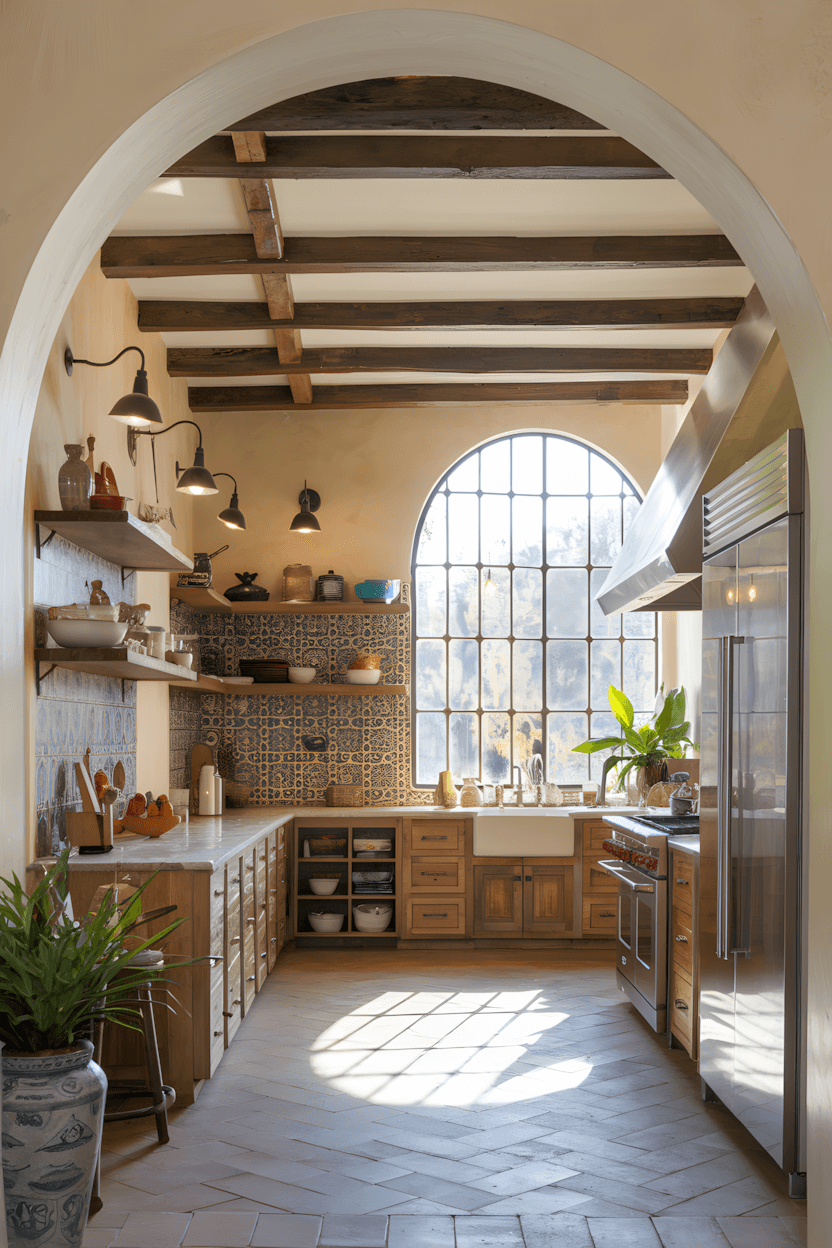
This approach uses traditional Spanish earth tones to create both beauty and functionality.
Key Functional Elements:
- Exposed wooden beams for structural authenticity – provides genuine architectural interest while serving structural purposes
- Colorful patterned backsplash for practical protection – protects walls while adding traditional Spanish ceramic artistry
- Mixed material cabinetry for varied storage – accommodates different storage needs while maintaining visual interest
- Terracotta floor tiles for thermal comfort – provides natural temperature regulation and easy maintenance
Earth tone functionality: Traditional Spanish colors weren’t arbitrary—they reflected local materials that performed well in Mediterranean climates.
8. Arched Alcove Traditional Design
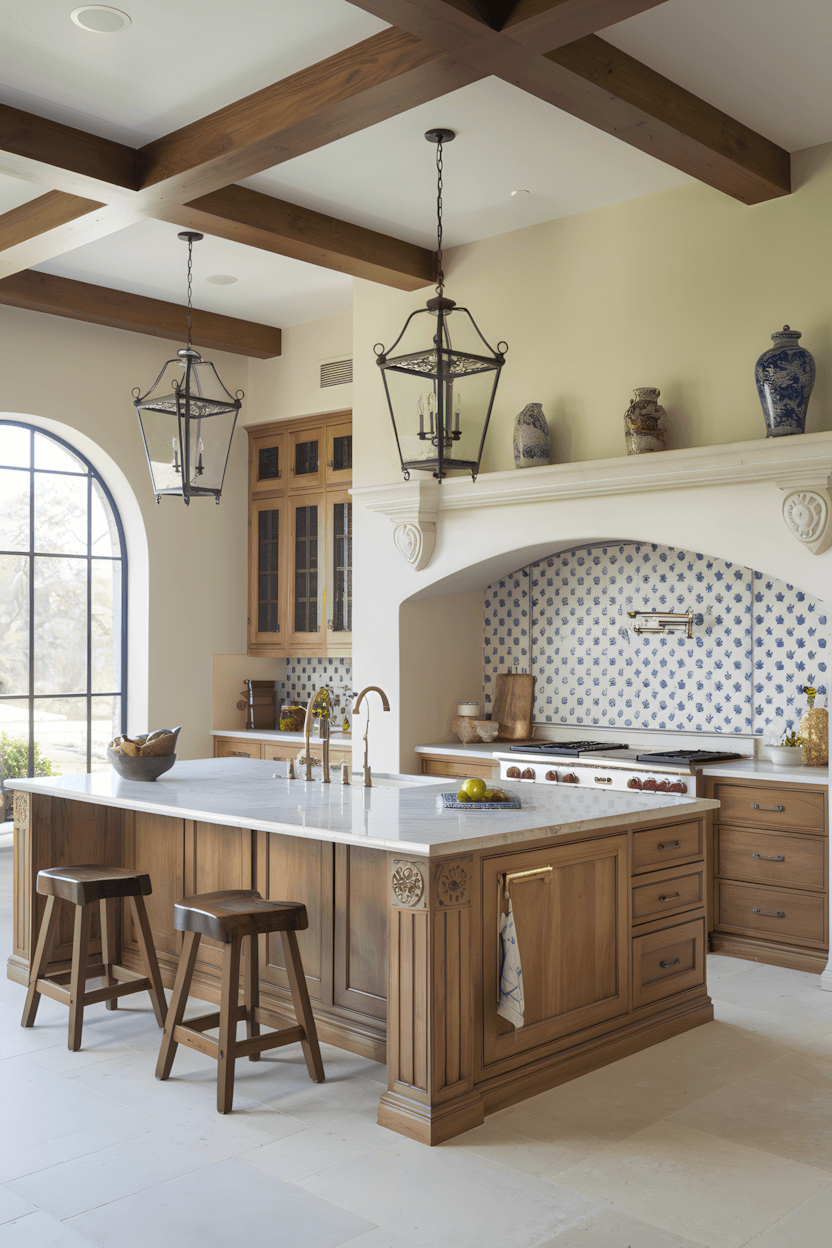
This design showcases how traditional Spanish architectural elements can enhance modern kitchen functionality.
Key Functional Elements:
- Large marble island for multiple prep zones – accommodates several cooks working simultaneously, traditional in Spanish family cooking
- Ornate lantern lighting for authentic ambiance – provides adequate illumination while maintaining traditional Spanish lighting aesthetics
- Arched alcove for specialized storage – creates dedicated space for serving pieces or display items
- Blue and white tile pattern for easy maintenance – uses traditional colors in practical application
Architectural integration: Spanish kitchen alcoves traditionally housed bread ovens or specialty storage—modern versions can accommodate coffee stations or display areas.
Contemporary Spanish Adaptations
9. Traditional Contemporary Mirror
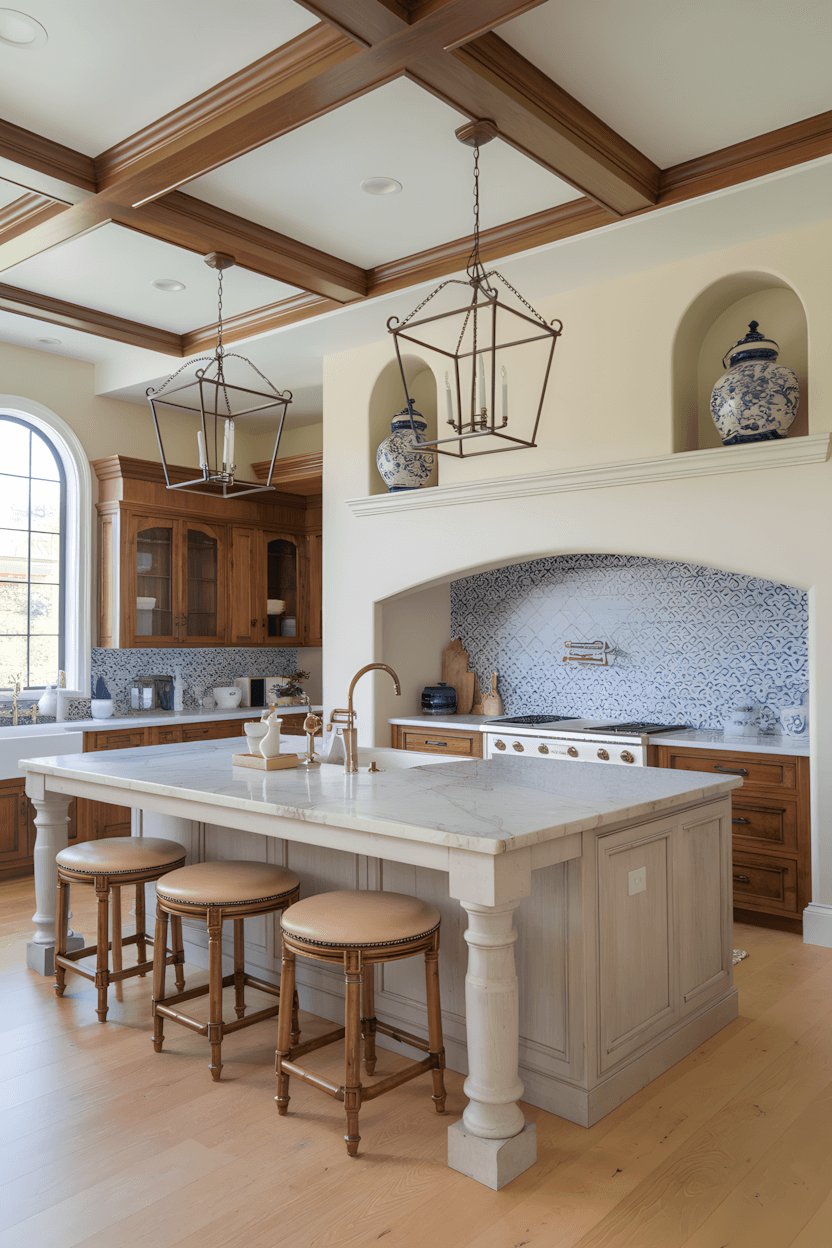
This parallel design approach demonstrates consistency in Spanish kitchen principles across different material applications.
Key Functional Elements:
- Consistent island proportions for workflow – maintains proper relationships between prep, cooking, and cleanup zones
- Lantern-style lighting for ambient illumination – provides necessary light while maintaining traditional Spanish atmosphere
- Wooden ceiling details for acoustic comfort – reduces kitchen noise while adding authentic architectural interest
- Traditional tile patterns for easy cleaning – combines practical maintenance with authentic Spanish ceramic traditions
Design consistency: Successful Spanish kitchens maintain proportion and material relationships even when adapting to different layouts or budgets.
10. Bright Airy Spanish Integration
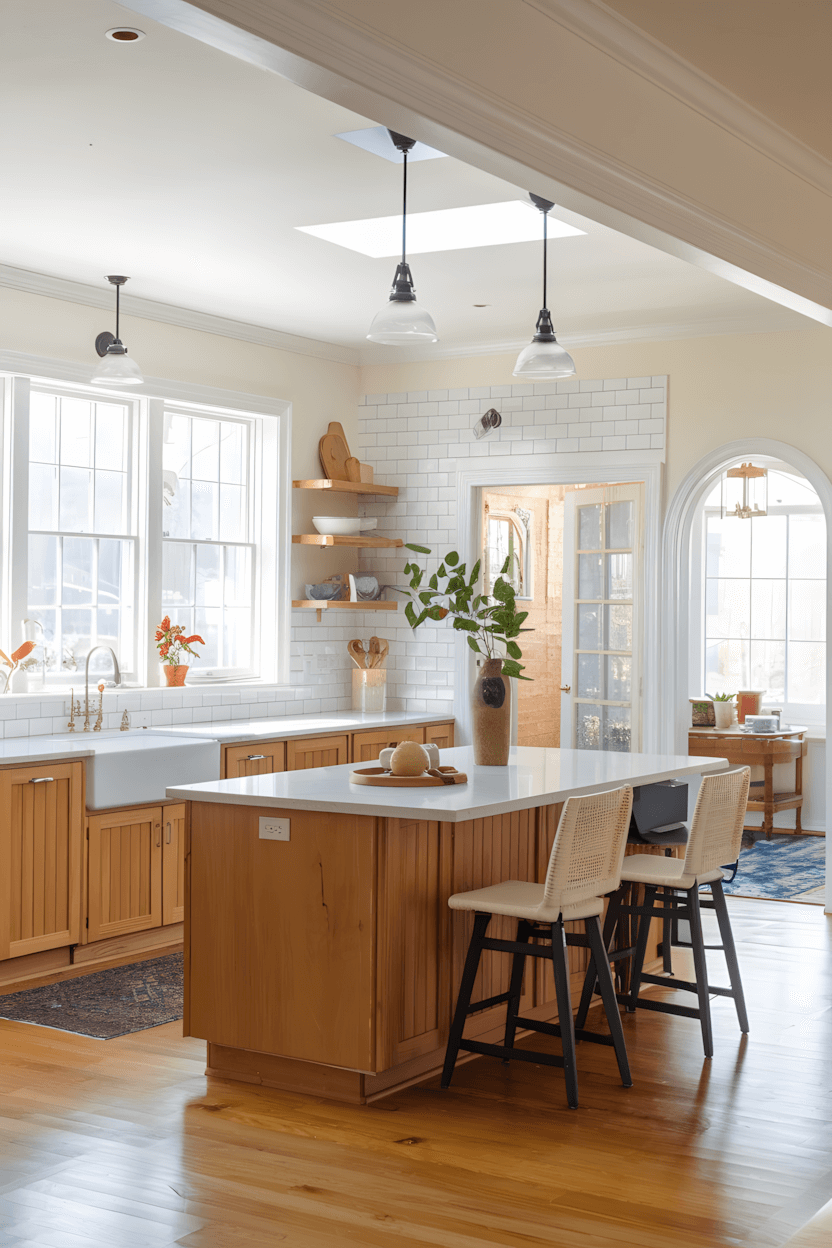
This approach maximizes light and space while maintaining Spanish character through strategic element placement.
Key Functional Elements:
- Central island for efficient workflow – creates classic kitchen triangle while providing social cooking space
- Subway tile backsplash for easy maintenance – uses practical tile solution while maintaining clean Spanish aesthetic
- Arched openings for spatial flow – connects kitchen to other living areas while maintaining architectural authenticity
- Mixed lighting for functional illumination – combines pendant task lighting with natural light optimization
Light maximization: Spanish kitchens traditionally prioritized natural light for food safety and energy conservation—modern versions enhance this with strategic artificial lighting.
11. Sophisticated Neutral Application
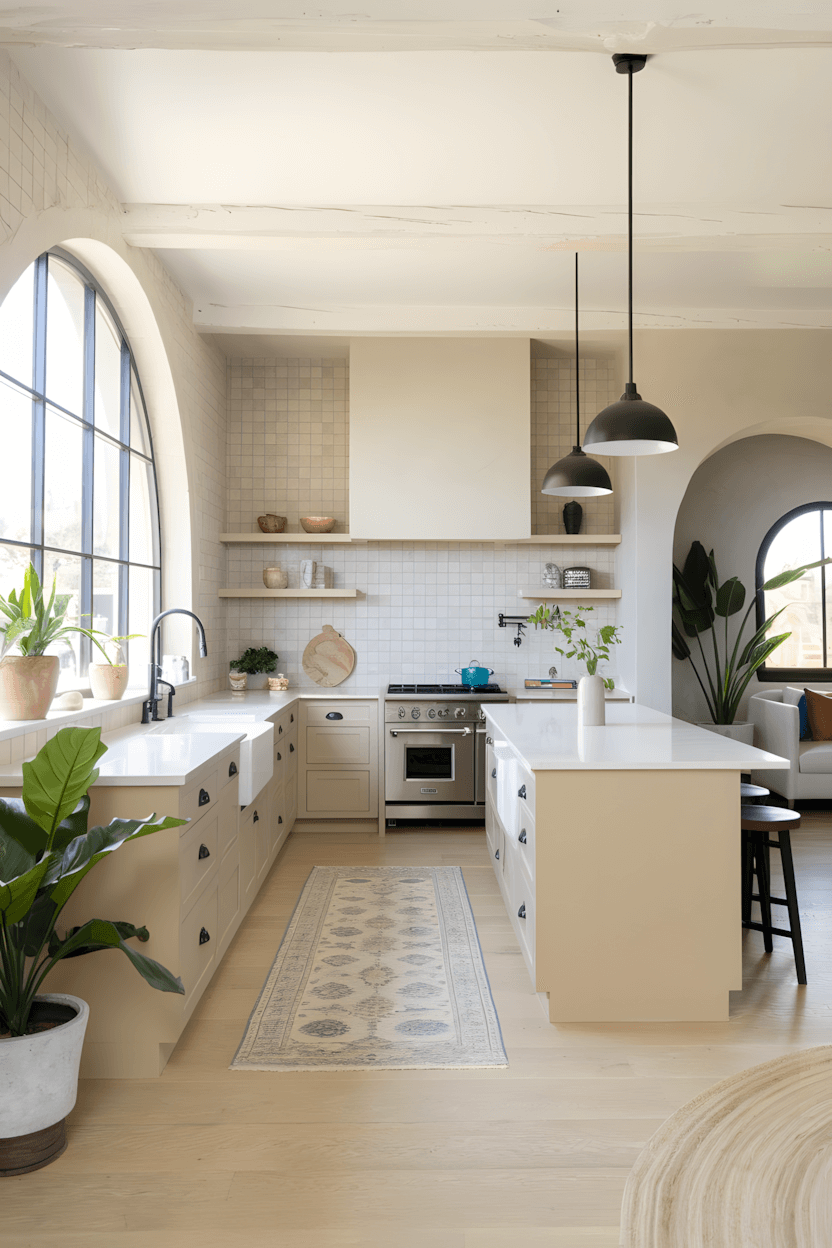
This refined approach demonstrates how Spanish warmth can be achieved through subtle material and color choices.
Key Functional Elements:
- Beige cabinetry for timeless appeal – provides neutral backdrop that won’t date while maintaining Spanish earth tone connections
- Contrasting hardware for functional durability – ensures hardware visibility while providing long-lasting operation
- Arched architectural elements for authentic character – maintains Spanish architectural language while serving modern functional needs
- Natural texture integration for warmth – uses rugs and plants to add Spanish-inspired comfort without permanent commitment
Neutral sophistication: Subtle Spanish elements often work better in modern homes than bold traditional features, while still providing authentic character.
Artisanal and Craft Integration
12. Mosaic Artistry with Practical Purpose
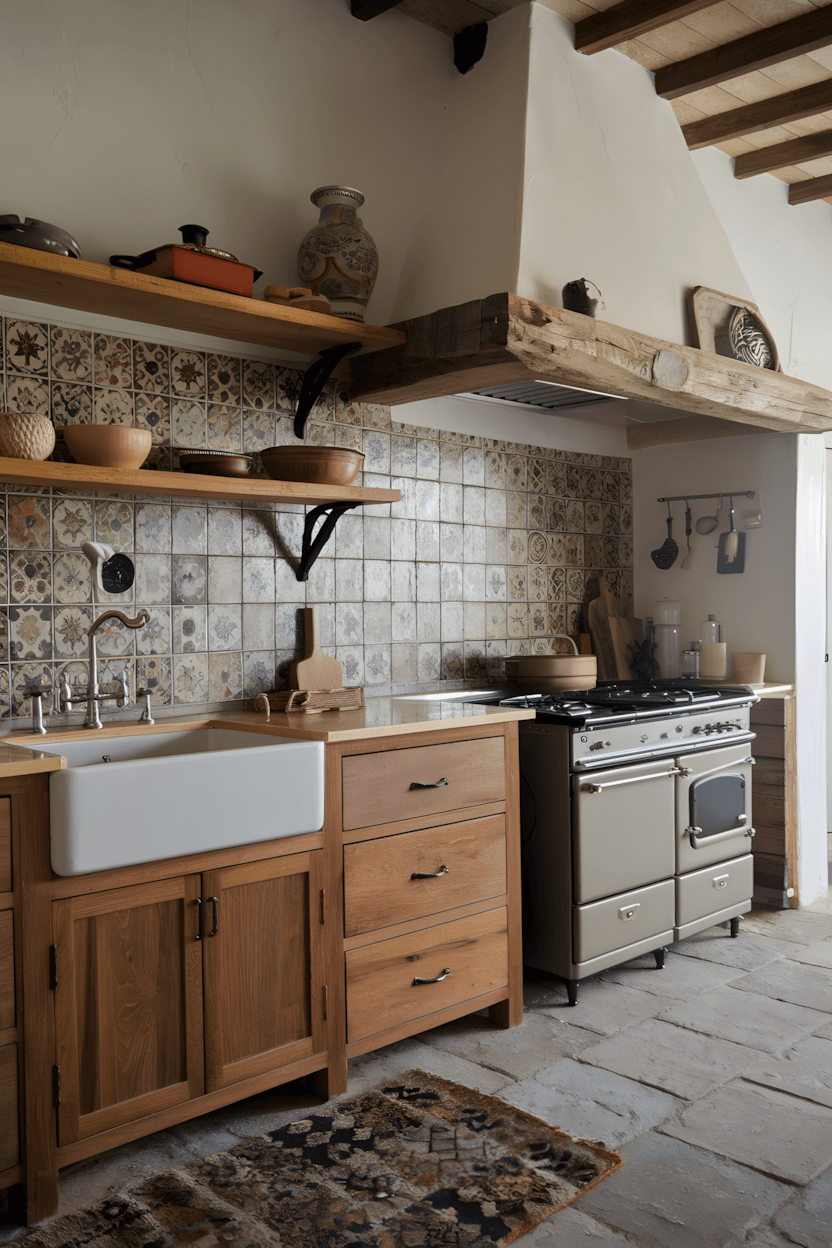
This approach showcases how traditional Spanish craft elements can enhance kitchen functionality.
Key Functional Elements:
- Intricate mosaic backsplash for splash protection – provides necessary wall protection while displaying traditional Spanish tilework artistry
- Open wooden shelving for functional display – keeps frequently used items accessible while showcasing beautiful cookware
- Exposed ceiling structure for authentic character – maintains traditional Spanish architectural honesty while providing visual interest
- Irregular floor tiles for authentic texture – uses traditional flooring that hides wear while providing slip resistance
Craft integration: Traditional Spanish kitchen craftsmanship served functional purposes—modern applications should maintain this practical beauty.
13. Cozy Central Hub Design
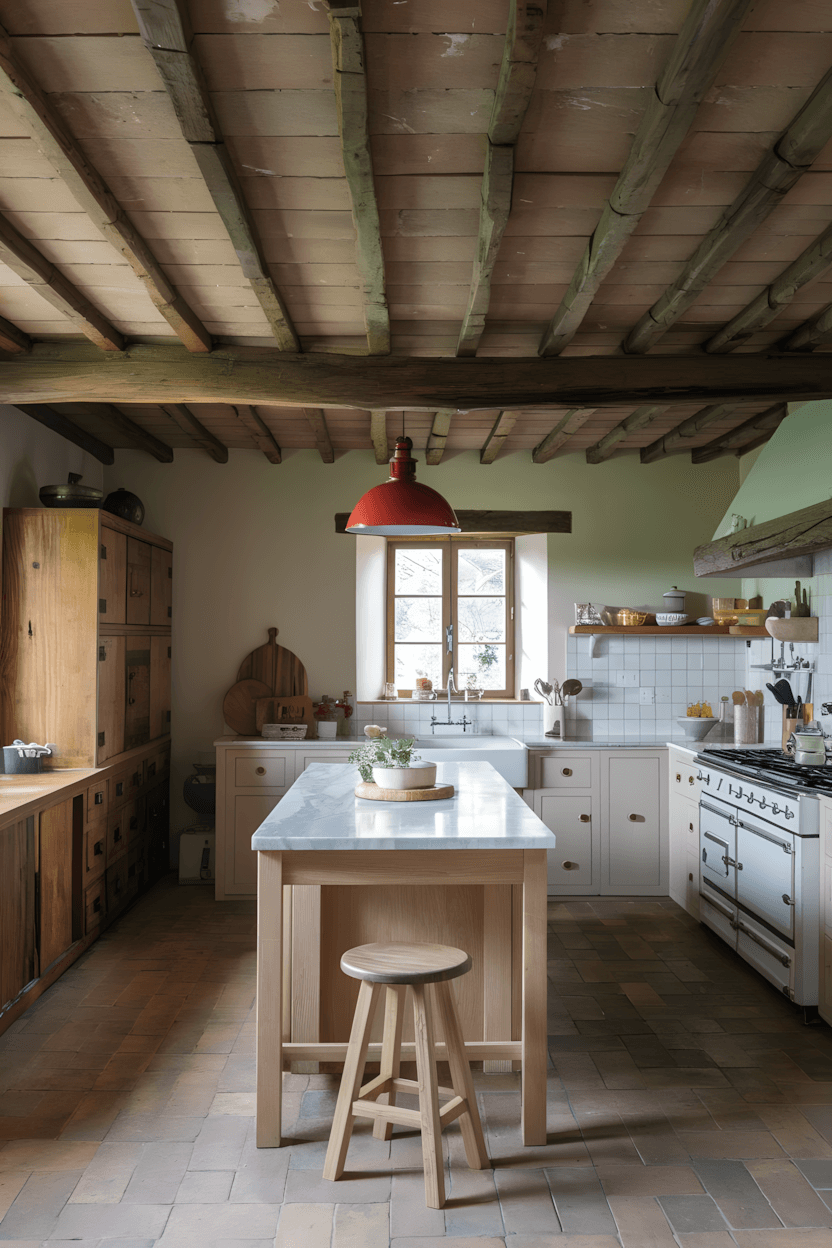
This intimate approach creates the family-centered cooking environment traditional in Spanish homes.
Key Functional Elements:
- Central island for social cooking – provides workspace for multiple family members while maintaining conversation
- Quality pendant lighting for task focus – ensures adequate illumination for detailed food preparation
- Efficient storage organization – keeps cooking essentials accessible while maintaining clean visual lines
- Balanced material palette for comfort – combines warm and cool elements for visual and thermal comfort
Family integration: Spanish kitchens traditionally served as family gathering spaces—successful modern versions maintain this social function.
14. Playful Material Combination
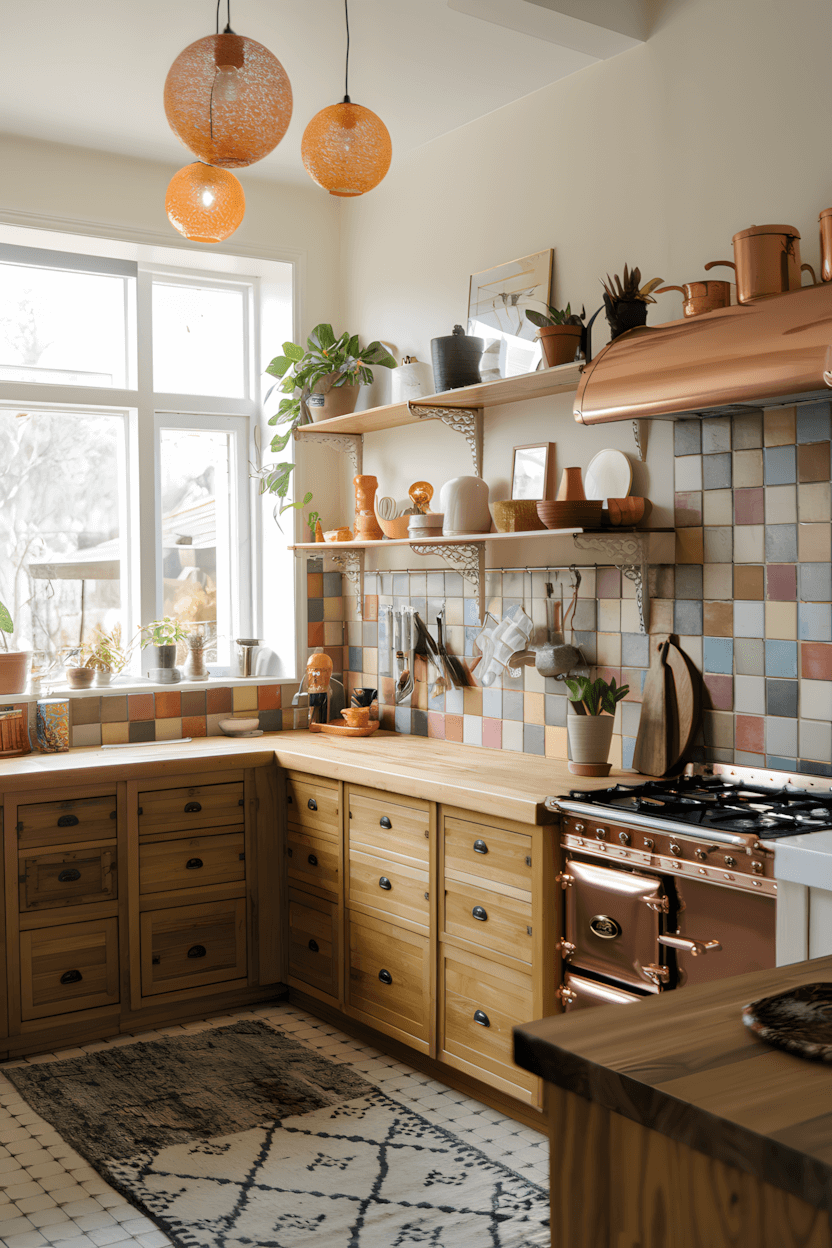
This approach demonstrates how Spanish kitchen warmth can incorporate contemporary color and lighting choices.
Key Functional Elements:
- Bold pendant lighting for personality – adds contemporary flair while providing necessary task illumination
- Mixed material countertops for varied functions – uses different surfaces for different cooking tasks
- Open shelving for display storage – showcases cooking implements and ingredients as decorative elements
- Modern appliance integration – incorporates contemporary cooking technology within traditional aesthetic framework
Contemporary integration: Modern Spanish kitchens can incorporate contemporary elements when they enhance rather than compete with traditional functionality.
15. Traditional Dining Integration
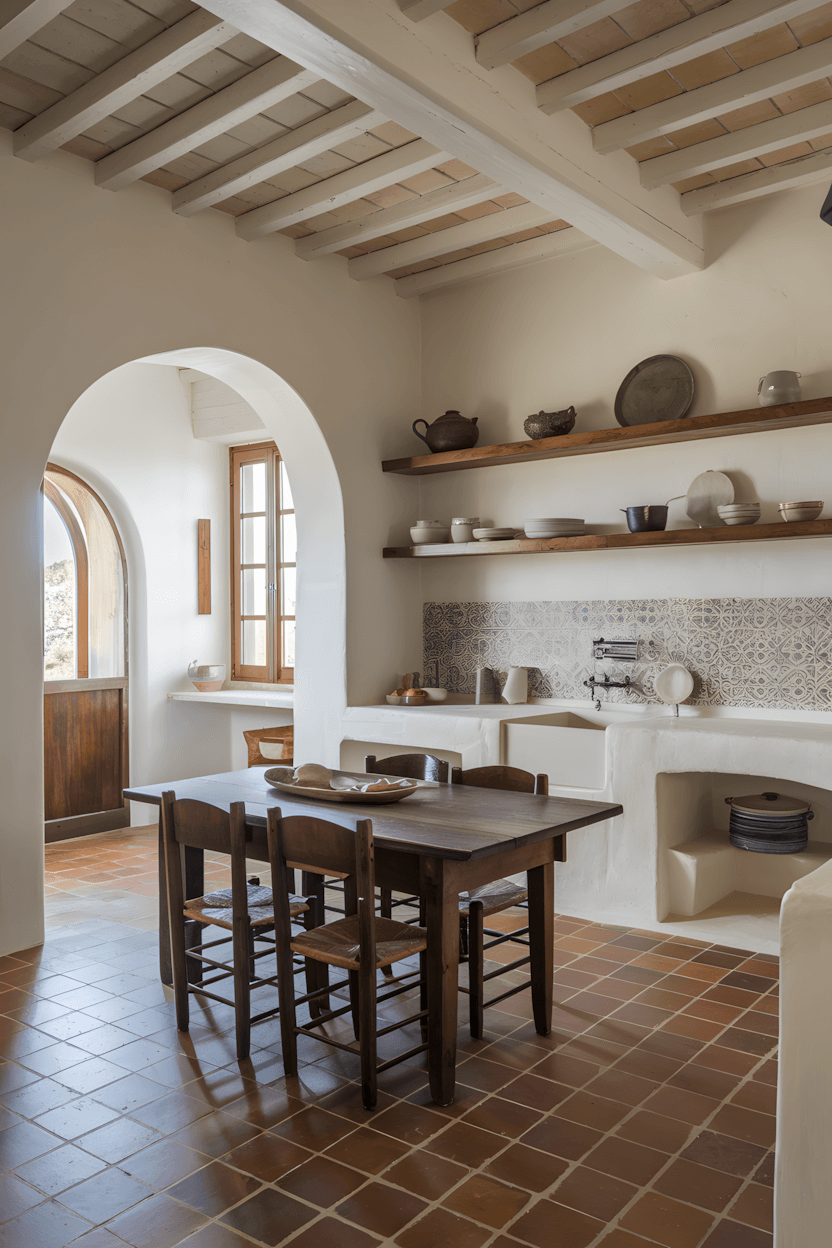
This comprehensive approach shows how Spanish kitchens can incorporate dining areas while maintaining cooking functionality.
Key Functional Elements:
- Central dining table for family meals – recreates traditional Spanish kitchen dining arrangement
- Surrounding storage for table service – keeps dining essentials accessible while maintaining organized appearance
- Arched architectural flow – connects cooking and dining areas while maintaining spatial definition
- Natural light optimization – ensures comfortable dining environment while supporting cooking tasks
Dining integration: Traditional Spanish kitchens included family dining areas—modern versions should accommodate this cultural expectation.
Creating Functional Modern Spanish Kitchens
After years of Spanish kitchen projects, I’ve learned that successful modern Spanish kitchens balance three essential considerations: authentic materials and techniques that genuinely improve cooking and maintenance, spatial organization that supports both individual cooking and family interaction, and contemporary conveniences that enhance rather than replace traditional cooking methods.
The Spanish kitchens that families love long-term are those that solve real daily challenges—efficient food preparation, easy cleanup, comfortable family interaction—while providing the warmth and character that drew them to Spanish style initially.
Focus on understanding how traditional elements served practical purposes rather than copying them purely for appearance.
Most importantly, adapt Spanish principles to your family’s actual cooking and entertaining patterns.
The goal isn’t to recreate a museum of Spanish design, but to apply time-tested principles for creating beautiful, functional kitchens that genuinely support your family’s daily life and cultural values.
Which of these authentic Spanish approaches matches your cooking style, family needs, and vision for warm, functional kitchen living?

